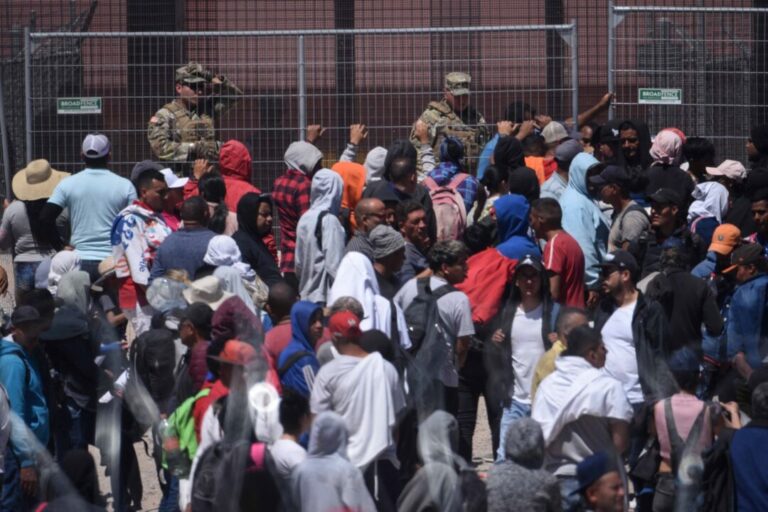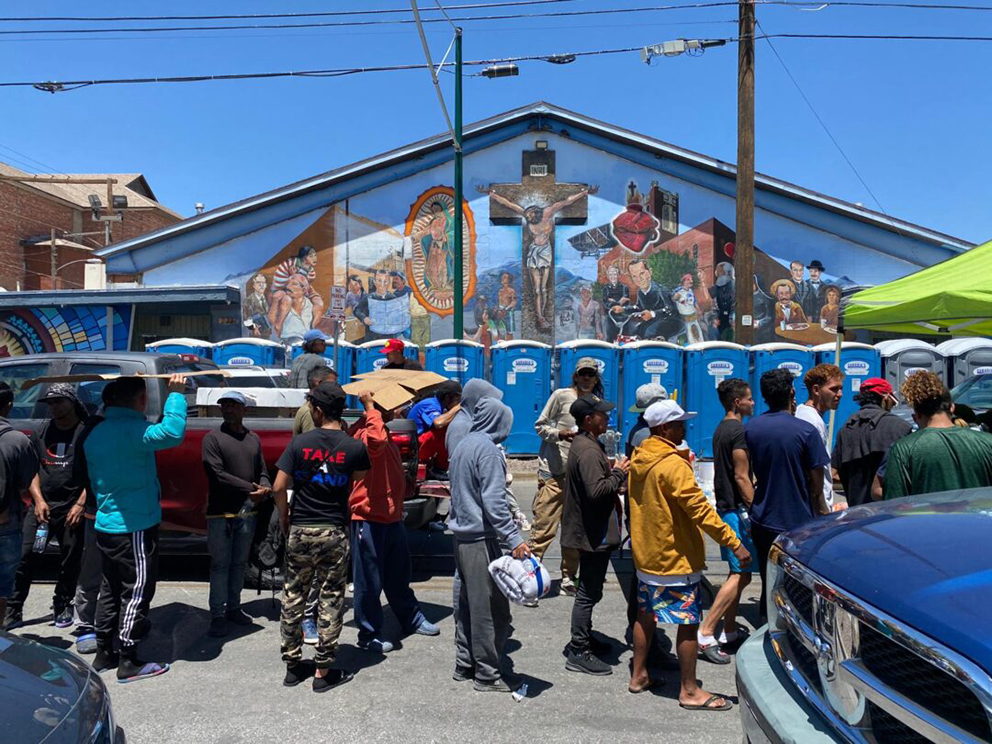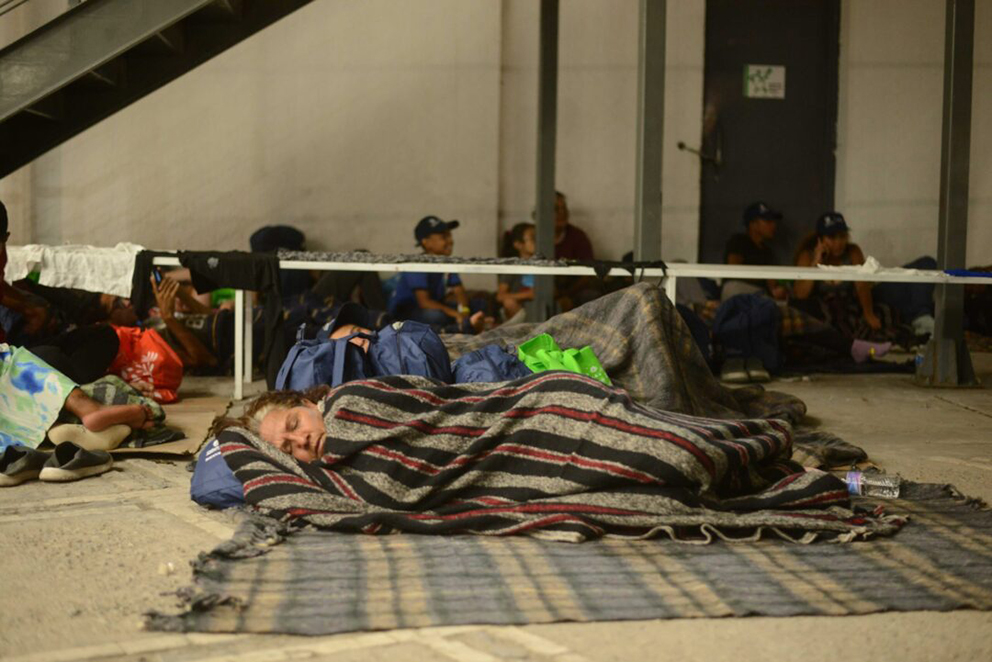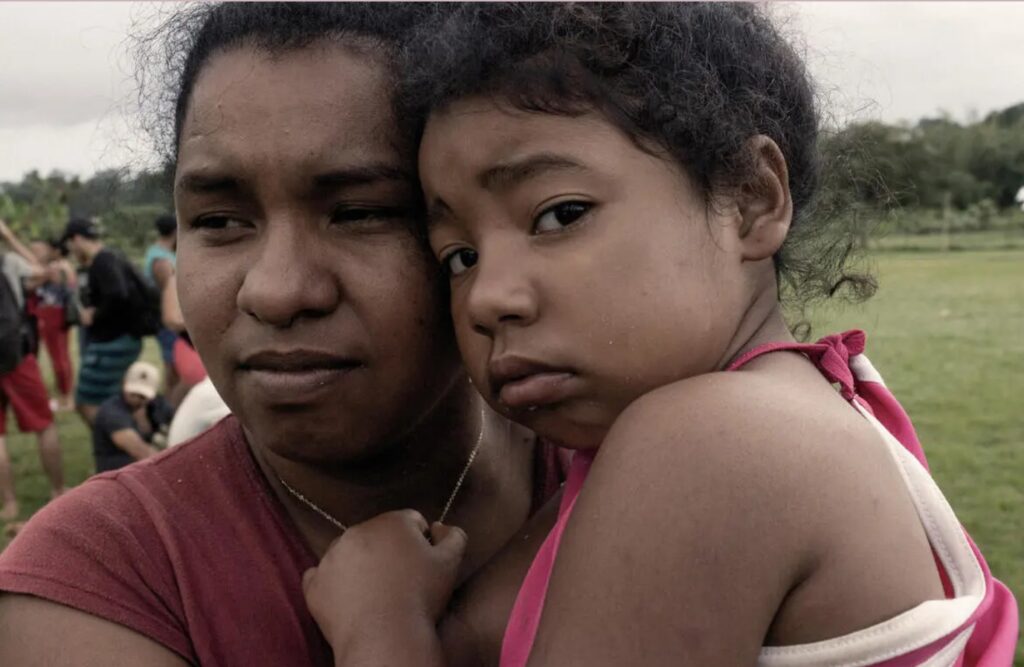
Text: La Verdad Juárez, with the collaboration of Aldrete and Vianey Contreras.
Photo: Vianey Alderete Contreras and Rey R. Jauregui / La Verdad
What is happening at the U.S.-Mexico border?
Thousands of migrants have gathered south of the U.S.-Mexico border, especially between Ciudad Juarez and El Paso, and some have crossed illegally into the United States to gamble their fate and seek asylum without being immediately returned to Mexico.
The Title 42 law that emerged during the Covid-19 pandemic to reject asylum seekers comes to an end this May 11 at 23:59 hours, and prior to its conclusion the government of Joe Biden faces the arrival of thousands of migrants from Mexico, Latin America, and countries from other continents who try to apply for this order before its conclusion, even though this policy does not mean that the border is open.
Migrants of all ages have arrived illegally on both sides of the border after a long journey from their home countries with no legal, housing, or income arrangements. Migrants have gathered in the streets of border cities waiting for May 11. In Ciudad Juarez, people were initially seen living in the center of the city, outside churches, and in migrant shelters, where some were able to find a safe place to live temporarily, and to get food and medical care.

Many migrants have been successful in crossing into the United States, but even so, some have been met by the Border Patrol at unauthorized points and then returned to Mexico or released in cities like El Paso, Texas, while the courts hear applications for asylum or other deportation orders.
In the first week of April, warnings issued by the U.S. State Department and Department of Homeland Security estimate that about 7,000 migrants per day will arrive at the border.

What is Title 42?
Title 42 policy is a public health order implemented by the Centers for Disease Control and Prevention (CDC) in March 2020 during the covid-19 pandemic. This immigration law will come to an end on May 11, 2023.
The law allows immigration agents to expeditiously remove people attempting to cross the border, with the goal of preventing people who might be infected with the virus from entering the country and stopping the spread of the disease.
However, the U.S. Department of Homeland Security (DHS) has said that people crossing after Title 42 ends will be subject to an immigration law that could still lead to deportation.
Since its institution three years ago, Title 42 has been used to turn away 2.5 million cases of migrants who have arrived at the border seeking asylum, and have been immediately removed.
Initially, the Centers for Disease Control and Prevention (CDC) had May 23, 2022 as the date for the order to be lifted, but because of controversy within the country, in April 2022, federal judge Robert Summerhays extended Title 42 until May 11 of this year.
Judge Summerhays, who was appointed to the position by former President Trump, ruled that 24 states that sued the Biden administration for attempting to repeal Title 42 were correct because his administration did not follow proper procedure.
Adding to the controversy of how the U.S. has dealt with migration during the pandemic and migrants’ attempts to gain asylum, in April 2022, following Russia’s invasion of Ukraine, the government launched the United for Ukraine refugee program. This gives Ukrainians seeking refuge the opportunity to stay temporarily in the United States for up to two years at the direction of the United States, and only allows them to enter its territory by air.

What is the Mexican government doing?
Mexico has became a waiting room for the thousands of migrants waiting for the end of Title 42. But the constant migration of people coming from Central American countries, Cuba, Ecuador, Colombia and Venezuela, among other countries was already present since October 2018, with the first caravan of migrants arriving at the Paso del Norte International Bridge.
The environment created by the Donald Trump Administration added to the idea that as time passed, their chances of crossing into the United States successfully would be a possibility.
The Casa del Migrante reached its capacity limit in a short time, and with this demand for help for migrants, the federal government opened the Albergue Leona Vicario, and the municipal government opened a shelter for migrants in the Gimnasio Municipal Kiki Romero.
Outside of the government, churches, non-profit organizations, and community members began to improvise and receive migrants in churches and a network of shelters was created.
What is the U.S. government doing?
The U.S. government’s response to the increase in migrant arrivals has been to send personnel before May 11 to increase security, with the expectation that around 7,000 migrants will arrive daily at the border.
Joe Biden’s administration has sent 1,500 military personnel to be stationed at the border for 90 days to support the public authorities already there, but they will not be conducting police work.
There are currently 2,500 U.S. National Guard on the border with the intention of giving the Department of Homeland Security and Customs and Border Protection (CBP) the freedom to focus on their primary responsibilities of guarding the country from terrorists and their weapons.
What is happening at the Ciudad Juarez – El Paso border?
El Paso, Texas is home to hundreds of migrants from 89 countries. In Ciudad Juarez, the most popular nationalities are Cubans, Haitians, Venezuelans, Ecuadorians and Central Americans.
The flow of people passing to the northern side of the border has caused great confusion among migrants.
Migrant tragedy prior to the end of Title 42
On March 27 of this year, one of the biggest tragedies to occur during the timeframe of the turmoil caused by the upcoming termination of Title 42 occurred in Ciudad Juarez. Forty migrants from Guatemala, Honduras, El Salvador, Venezuela and Colombia died in a fire at the temporary migrant holding station of the National Migration Institute (INM). The fire occurred in the men’s cells, in that area, which was under lock and key, there were 68 male migrants, some of them returned by the United States to Mexico under Title 42 and others who were secured by INM agents in a special operation carried out in conjunction with authorities of the municipality of Juarez to remove them from the crossroads where they clean windows, sell candy or ask for money.
What will happen with the end of the Title 42 policy?
The border will not be open.
With the expiration of Title 42 immigration law, the Border Patrol will resume processing migrants at the U.S.-Mexico border under the usual/usual/normal/established immigration laws of Title 8.
The U.S. Department of State (USDS) specified that the end of Title 42 does not mean that the border will be open. The USDS also announced that the plan to follow with this change will result in fewer illegal crossings by increasing legal ways to migrate and expedited removals that will take a few days for those who do not use these procedures and choose to cross illegally.
In order to arrive at the border and be attended to by the immigration offices at the port of entry, a specific appointment must be made. Those without an appointment will be ineligible for asylum unless they are in an applicable exception situation.
Those who are removed for unlawful entry will be barred from re-entering the United States for a minimum of five years, and if they are deported (ordered removed as it says in the community, they will be ineligible to apply for asylum.
Among the positive aspects of the end of Title 42 are that there will be more legal options for entering the United States includes the CBP One mobile app, available for download in the Apple App Store or Google Play Store. CBP One is used to schedule U.S. immigration appointments. But only migrants located in central and northern Mexico who are not already at ports south of the U.S. will be eligible.
The U.S. will also accept up to 30,000 migrants from Venezuela, Cuba, Haiti, and Nicaragua as part of expanded humanitarian waivers. The number of migrants from countries in the Western Hemisphere, such as those in the Americas, including Antigua and Barbuda, Barbados, Belize, Bolivia, Costa Rica, Dominican Republic, Ecuador, El Salvador, Peru, Trinidad and Tobago, and Uruguay, will also double.
Countries on the African continent located in the Western Hemisphere include Morocco, parts of Algeria and parts of the Polynesian islands, and parts of European countries such as Portugal, Spain, the United Kingdom, and France.
What is Title 8?
Title 8 immigration law includes all of the country’s immigration laws used prior to Title 42, including asylum proceedings.
Criminal prosecutions have major consequences for crimes such as entering the country without inspection, re-entering the country after being deported, and removing migrants who are categorized as inadmissible.
This article was originally published in LA VERDAD JUÁREZ, which is part of the Alianza de Medios de la Red de Periodistas de a Pie on May 10th, 2023. English translation by Schools for Chiapas.
Following the end of Title 42, UNHCR and IOM express concern over new restrictions

*Andres Manuel Lopez Obrador announced the deployment of more elements of the National Guard (NG) to the southern border, following the end of Title 42 in the United States. Although he did not specify the number of elements that would arrive, he did detail that their function will be to: control the passage of people without using violence and also to avoid provocations.
The Title 42 law that was passed during the Covid-19 pandemic to reject asylum seekers came to an end this May 11 at 11:59 pm.
The end of this provision comes in the context of the second half of Joe Biden’s administration, which has faced a wave of migrants from Mexico, Latin America, and countries from other continents who tried to apply for this order before its conclusion, despite the fact that this policy does not mean that the border is open.
In this regard, the UN Refugee Agency (UNHCR) and the International Organization for Migration (IOM) urged a collaborative approach to better respond to mixed movements of refugees and migrants in the Americas.
They welcome positive initiatives to expand resettlement and other regular pathways in the region. However, they expressed concern about new restrictions affecting access to asylum following the lifting of the Title 42 public health order by the United States.
However, they noted that the number of people approaching the U.S. border has increased in recent years: the majority of people in a situation of human mobility in the Americas continue to be hosted by Latin American countries.
“No country can solve the challenges posed by refugee and migrant movements in isolation. Effective progress can only be achieved through joint efforts to address the causes of displacement and irregular migration, said UNHCR and IOM.”
This includes supporting the communities that host the majority of displaced persons, providing access to fair and efficient asylum procedures and other legal stay mechanisms, and facilitating access to safe and regular pathways as alternatives to dangerous journeys.
“A more effective response requires a collaborative effort by States and other stakeholders to expand access to protection and asylum and regular migration channels, while strengthening solutions,” the organizations said.
Therefore, the U.S. initiative to expand resettlement for refugees and other regular access routes is a positive step, which can offer real alternatives to desperate people who risk their lives to find safety and solutions.
That is, facilitating and expanding access to resettlement, family reunification, humanitarian sponsorship and labor mobility programs can save lives and protect people from trafficking, smuggling and other forms of violence.
For, if properly managed, they can support national economies facing labor shortages. For that reason, UNHCR and IOM are willing to redouble their efforts to work with all countries and existing regional mechanisms to make this a reality.
However, the expansion of resettlement and other regular channels cannot substitute for the responsibility of states to guarantee people access to territory and asylum procedures.
This is because restrictions that hinder the exercise of the fundamental human right to seek asylum are unacceptable and contrary to the international obligations of States. The new rule adopted by the U.S. government restricting access for asylum seekers arriving irregularly, after transiting through another country, is incompatible with the principles of international refugee law.
This article was published in Chiapas Paralelo on May 14th, 2023. https://www.chiapasparalelo.com/noticias/chiapas/2023/05/tras-fin-del-titulo-42-acnur-y-oim-expresaron-su-preocupacion-por-nuevas-restricciones/
